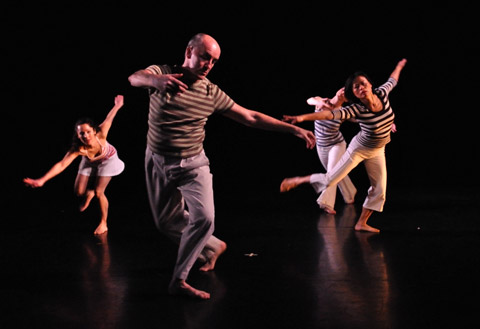
FRIENDS Crabtree and his dancers may not be doing a lot of tricks, but they move with clarity and deliberation. |
Brian Crabtree used his two-week Dance Residency at Boston Center for the Arts to revisit some of his old pieces, make a start on some new ones, and offer a chunk of his movement DNA to three other choreographers. The result was new(F)angle, which got shown in a studio last weekend at the Calderwood Pavilion. The 10 dance fragments looked like a close-knit family with a couple of fractious siblings.
When I studied some extended program credits, I could see that the hour's selections fell roughly into three parts, each based on an older work of Crabtree's. We saw the original dance, or an excerpt from it, and a new offspring by Crabtree, plus a response by another choreographer. Crabtree's past-and-present views shared the same pieces of concert music. The guest choreographers chose funky contemporary songs and instrumentals.
Crabtree's movement vocabulary comes from modern dance and simple actions like pacing, falling backward, encircling your partner with your arms. After a season of hard-edged, dazzling dancing, his looks soft, comfortable. The dancers may not be doing a lot of tricks, but they move with clarity and deliberation. Neither showy nor introspective, they go about things in a plainspoken way, like the good friends they probably are.
Crabtree has a musical soul. It's the expressive musical gesture and flow that propels his choreography, not the structural neatness with which he organized the program. The pieces were too short for one to detect much structure anyway. Sometimes his musical choice hints at comedy or irony, but he doesn't push it.
In the program opener, Slip (1997), he and Alison Ball are both wearing clingy white slips, Crabtree having undressed and put his on while giving an introductory talk to the audience. He and Ball dance side by side with movement that isn't particularly suggestive, except that they're both carrying flapjack turners. Without emphasis, they incorporate these implements into the movement, as if they were mirrors, pillows, extensions of their hands to scoop each other closer. Romantic piano music by Brahms accompanies this anti-seduction. In Get Up Three, Audra Carabetta, Yenkuei Chuang, and Joelle Garfi, spatula-less, take this movement and the first part of the same Brahms piece (Opus 116 No. 4) into a strolling trio with careful falls.
Nicole Pierce's riff on this, Little Bit, was accompanied by a track from the experimental Icelandic rock band Múm. All I remember is Pierce crawling across the floor, one hump at a time, to a combo that included accordion, tinkly percussion, and a booming drum.
In Crabtree's 1999 duet with Carabetta, Now You See It, which is set to strings-and-guitar music by Gavin Bryars, the dancers moved in close circles, answering one shape with another but never quite settling or fitting together. They were joined by Ball for the sequel, Around My Doubt, where one dancer paced the perimeter of a square and the others danced in the center. Jody Weber mugged as a Counter Girl to an out-of-tune piano and an unidentified girlchild voice singing the Eagles' "Desperado."